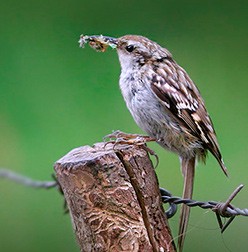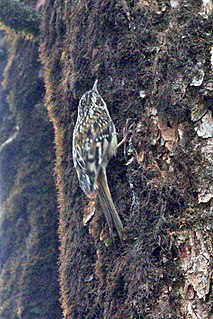The Sibley-Monroe checklist was a landmark document in the study of birds. It drew on extensive DNA-DNA hybridisation studies to reassess the relationships between modern birds.

The treecreepers are a family, Certhiidae, of small passerine birds, widespread in wooded regions of the Northern Hemisphere and sub-Saharan Africa. The family contains ten species in two genera, Certhia and Salpornis. Their plumage is dull-coloured, and as their name implies, they climb over the surface of trees in search of food.

The Philippine creepers or rhabdornises are small passerine birds. They are endemic to the Philippines. The group contains a single genus Rhabdornis with three species. They do not migrate, other than to make local movements.

The Indian spotted creeper is a small passerine bird, which is a member of the subfamily Salpornithinae which is placed along with the treecreepers in the family Certhiidae. This small bird has a marbled black and white plumage that makes it difficult to spot as it forages on the trunks of dark, deeply fissured trees where it picks out insect prey using its curved bill. It is found in patchily distributed localities mainly in the dry scrub and open deciduous forests of northern and central peninsular India. It does not migrate. Their inclusion along with the treecreepers is not certain and some studies find them more closely related to the nuthatches while others suggest a close relation to the wallcreeper. They lack the stiff tail feathers of treecreepers and do not use their tail for supporting them while creeping vertically along tree trunks.

There are 7 species of Australasian treecreeper in the passerine bird family Climacteridae. They are medium-small, mostly brown birds with patterning on their underparts, and all are endemic to Australia-New Guinea. They resemble, but are not closely related to, the Holarctic treecreepers. The family is one of several families identified by DNA–DNA hybridisation studies to be part of the Australo-Papuan songbird radiation. There is some molecular support for suggesting that their closest relatives are the large lyrebirds.

The Eurasian treecreeper or common treecreeper is a small passerine bird also known in the British Isles, where it is the only living member of its genus, simply as treecreeper. It is similar to other treecreepers, and has a curved bill, patterned brown upperparts, whitish underparts, and long stiff tail feathers which help it creep up tree trunks. It can be most easily distinguished from the similar short-toed treecreeper, which shares much of its European range, by its different song.

The short-toed treecreeper is a small passerine bird found in woodlands through much of the warmer regions of Europe and into north Africa. It has a generally more southerly distribution than the other European treecreeper species, the common treecreeper, with which it is easily confused where they both occur. The short-toed treecreeper tends to prefer deciduous trees and lower altitudes than its relative in these overlap areas. Although mainly sedentary, vagrants have occurred outside the breeding range.

The Pallas's grasshopper warbler is an Old World warbler in the grass warbler genus Helopsaltes. It breeds in east Asia. It is migratory, wintering from India east to Indonesia, where it is a rare migrant in Sri Lanka.

The brown creeper, also known as the American treecreeper, is a small songbird, the only North American member of the treecreeper family Certhiidae.

The white-throated treecreeper is an Australian treecreeper found in the forests of eastern Australia. It is unrelated to the northern hemisphere treecreepers. It is a small passerine bird with predominantly brown and white plumage and measuring some 15 cm (6 in) long on average. It is insectivorous, eating mainly ants. Unlike treecreepers of the genus Climacteris, the white-throated treecreeper does not engage in cooperative breeding, and wherever it overlaps with species of that genus, it feeds upon much looser bark besides typically using different trees.

Salpornis is a genus of bird which is usually included in the Certhiidae family. The genus has in the past been included with the nuthatches in the family Sittidae or placed in a family of its own, the Salpornithidae. Molecular phylogenetic analyses show them to be definitely within the Certhioidea but still leaves some uncertainty about their placement in relation to the genera Sitta, Tichodroma and Certhia. While they appear similar to the treecreepers (Certhia), they do not use their tails to support them while climbing and some molecular evidence shows them to be closer to the nuthatches (Sitta) while another study suggests a closer relation to the wallcreeper Tichodroma muraria. The generic name is derived from the Greek salpinktes for wren and ornis for bird.

The Sichuan treecreeper is a rare species of bird in the treecreeper family, Certhiidae.

The bar-tailed treecreeper, or the Himalayan treecreeper is a species of bird in the family Certhiidae. It is found primarily in the northern parts of the Indian subcontinent, particularly in the Himalayas, as well as in adjoining regions. It is found in Afghanistan, India, Iran, Kazakhstan, Burma, Nepal, Tibet, Russia, Tajikistan, Turkmenistan, and Uzbekistan.
Its natural habitats are boreal forests and temperate forests.

The rusty-flanked treecreeper or the Nepal treecreeper is a species of bird in the family Certhiidae.
It is found in northern India, Nepal, Bhutan and western Yunnan.
Its natural habitats are boreal forests and temperate forests.

Cinnycerthia is a genus of bird in the wren family, Troglodytidae. It contains four species which inhabit the undergrowth of montane forests in the Andes. None of them are considered to be threatened with extinction and they are classified as species of Least Concern by BirdLife International. They are 14–16.5 cm long and have a fairly short bill and fairly plain reddish-brown plumage with dark bars on the wings and tail. The name of the genus is a combination of Cinnyris, a genus of sunbirds, and Certhia, a genus of treecreepers.

Hodgson's treecreeper, is a small passerine bird from the southern rim of the Himalayas. Its specific distinctness from the common treecreeper was recently validated.

Cryphoeca silvicola is a small species of dwarf sheet spider in the family Cybaeidae which has a Palearctic distribution. The generic name, Cryphoeca, means hidden and the specific name silvicola means "living in the woods".















